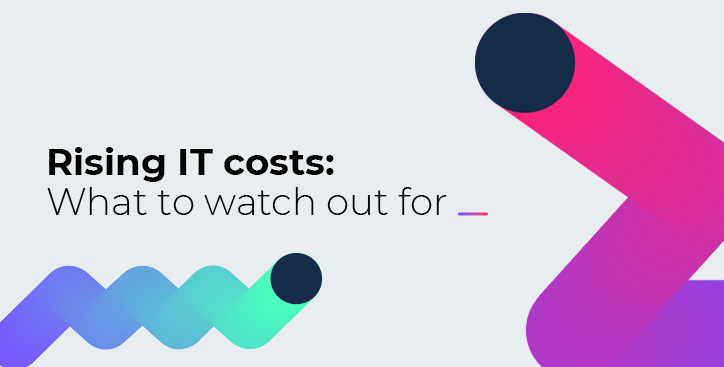Rising IT costs: What to watch out for
By Alex Hawkes|10 October, 2022

Watching out for rising cloud costs
But when it comes to the cloud, it’s not so simple, and it’s long been posited that one of the most significant concerns when it comes to cloud cost is that variation of compute, storage, and consumption models between different providers, which can be complicated, and often misunderstood.
In fact, in its 2022 State of the Cloud Report, Flexera estimated that 30% to 35% of all spend in the cloud was wasted usage access cycles, like leaving the lights and heating on in an unoccupied home, or running the car engine in the driveway. Except the power never goes out and the gas never gets to empty, but the bills keep coming.
One of the main draws of the cloud in terms of business agility, was that any function outside of IT could spin up a public cloud instance and get to work on a new project. However, it’s now thought that there are lots of abandoned projects out there that have dropped ‘off radar’ but are still being paid for.
The other trap about the all-you-can-eat-buffet that is the cloud, is that engineers are tempted to gobble up as many resources as they can in the name of innovation and experimentation with necessarily having any return to show on that investment.
Reducing cloud costs
There are however, steps that can be taken to reel in spiralling costs - there’s even a movement dedicated to it called Finops.
In Flexera’s 2022 State of the Cloud report, the company found that organisations are trying to better understand cloud costs in order to bring them down, with 64% focusing on maximising resource utilisation, and 50% engaging in deleting or removing unused or idle resources.
Ways that this can be done, include:
- Automation as a key tool for optimising cloud costs. Automated policies can shut down workloads after hours and ‘rightsize’ underutilised instances.
- Rightsizing is taking the time to spec the project and ensure you’re not over- or undersizing on resources. Too many resources for the application is wasteful, while too little can have a negative impact on performance.
- Standardising on development tools and environments. Given the wide variety of cloud platforms, it’s not unusual for developers to end up using different tools and platforms with no coherent DevOps strategy. Standardising on development tools and sharing innovations can reduce investments across the business.
- Similarly, designing applications ‘for the cloud’. It might not be a case of simply porting an on-premises application to a public cloud instance. If part of the cloud-native application is coded incorrectly, it could consume more resources than budgeted for.
- Migrating apps from data centres to public clouds isn’t always a simple lift-and-shift either. If a migration takes several months you may end up paying twice - for the old and the new environment - while the migration completes. Better instead to rationalise the new environment so costs rise in line with actual usage, and you’re not paying for storage and compute that’s sitting idle.
- Multi-cloud strategy. It’s worth noting that while many enterprises opt for multi-cloud either by accident or in order to access best-of-breed platforms, not being dependent on any one provider also gives you better bargaining power, which could be used to reduce costs.
Benefits of NaaS for cloud connectivity
There are, of course, costs associated with connecting to the cloud and the need to make networks more agile, scalable, and adaptable is more apparent now than ever.
Legacy WAN architectures are typically very cloud unfriendly and put considerable burden on the organisation to maintain. Appropriate connectivity for SaaS, IaaS, and PaaS is not easily achieved on traditional infrastructure and a suboptimal WAN can actually degrade the performance of cloud-based applications and adversely affect the end-user experience, as well as being expensive.
Especially useful for multi-cloud environments, Network-as-a-Service interconnection fabrics like Console Connect now have Points of Presence in so many cloud data centres it’s possible to spin up Layer 2 and Layer 3 connections into those clouds almost instantaneously to meet demand.
And finally, using a private on-demand network for cloud connectivity might help sidestep egress charges, which in some cases have gone from free to two cents per GB, which doesn’t sound like much. But in a high performance, cloud centric environment, every penny counts.


.jpg)





.jpg)
